|

|
TALA 9: [This is one of several pages published under this heading by LoughAllenBasin.com We endeavour to highlight what this area of NorthWest Ireland has to offer as a place to live, a place where interesting Plants and Animals may be found, and as a quiet peaceful location for Hi Tech Enterprise.]
BACK (to Index for this Section.) NEXT Topic (Shoreline Flowers) Lough Allen Basin HOME
loughallenbasin.com
|
|
|
UPDATE: A Special Study of the Common Tern (2011) can be found HERE
|
9. Gulls, Terns and Wading Birds
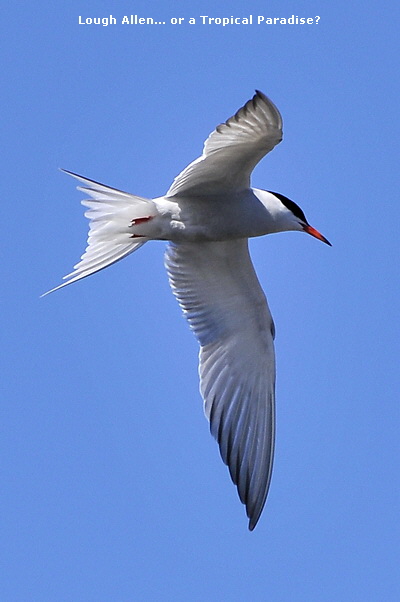 (4th July 2010) (4th July 2010)
Yes, it is Lough Allen in the early Summer 2010. This is a Common Tern.
Common Terns are struggling to breed in Lough Allen. Initially four were present this year, now reduced to just one pair. Lough Allen would be an ideal place for these birds to breed if only the problem of predation could be overcome.
Colour patterns are similar to a Gull but the behaviour and liveliness and the spectacular fishing and chasing that these birds undertake near their breeding areas marks this species out as a much more exciting and exotic bird.
Note the black tip to the bill and the 4 translucent inner primaries (main wing feathers) that distinguish this bird from the closely related Arctic Tern. The Common Tern winters along the west African coastline.
|
Location: East & North Shores of Lough Allen
Location of Study Sites
 Lough Allen is spawning new islands? Lough Allen is spawning new islands?
These two maps show the locations of the Gull, Wader and Tern breeding areas. Gulls only at the north end.
Apart from the big islands a lot of Lough Allen’s islands don’t seem to have any names. The blue labels are names we have given these islands. We have consulted the Maps and if there are any local names for these islands, we would be pleased to hear them.
Most of the islands named in blue are either shown smaller on earlier maps and don’t actually appear on the 1837 - 1842 map. Up to 1913 the water level is shown much higher with Drummans and Inishfale both shown well separated from the shore!
|
|
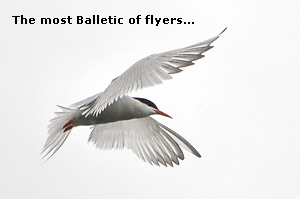
These three photos from Lough Allen show how accomplished, powerful, and agile are Common Terns in flight. Their scientific name compares them to Swallows!
|
|
Report:
This report has been produced in line with a commitment given to survey the Bird Life of the area with a view to a possible LIFE+ submission in 2011 or 2012. The species we are studying in this article are listed below along with their status. The 3 Gulls breeding in Lough Allen are, perhaps, three of our more attractive gulls and not the commonest either. Both the Lesser Black-backed Gull, with its yellow legs and dark grey back, and the Common Gull, with its demure appearance and habit of visiting recently cut meadows, are interesting and local species.
(Below) The Common Tern has longer legs and a whiter belly than the Arctic Tern
|
Conservation of Lough Allens vulnerable Birds |
International Status of the Birds listed on this page:
Lesser Black-backed Gull: Larus fuscus. Amber List
Common Gull: Larus canus. Amber List
Black headed Gull: Larus ridibundus. RED LIST
Common Tern: Sterna hirundo. Amber List
Lapwing: Vanellus vanellus. RED LIST
(Our other important wading bird, also on the Amber List has been reported on its own page. It is the Common Sandpiper. The Amber List records birds of Moderate Conservation concern. The RED LIST records species of High Conservation concern, i.e. species suffering major decline.
Consequently, all of these type of birds breeding on Lough Allen are species of significant or extreme conservation concern.
|
|
|
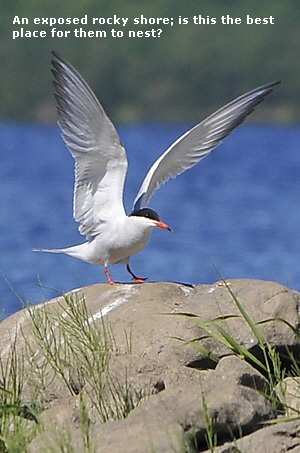 Like Lough Allen’s vulnerable plants, its birds too are very dependent on a stable water level. This year has been perfect. But such good weather has brought many birds into a very compressed breeding area. These Terns have established a base at the stony south end of The Spit. They are well able to attack other bigger birds but nests would be vulnerable to opportunistic attack by such predators as Grey (Hooded) Crows and the Lesser Black-backed Gulls. Like Lough Allen’s vulnerable plants, its birds too are very dependent on a stable water level. This year has been perfect. But such good weather has brought many birds into a very compressed breeding area. These Terns have established a base at the stony south end of The Spit. They are well able to attack other bigger birds but nests would be vulnerable to opportunistic attack by such predators as Grey (Hooded) Crows and the Lesser Black-backed Gulls.
Rafts in this area, such as are used in other countries, might entice Terns to stop and breed on their migration north. Could such pontoons be provided with ‘aerials’ to deter large birds from flying over to steal eggs but allowing the more agile Terns to land and nest?
|
|
|
|
|
|
Status of these Birds on Lough Allen:
To start with a simple and stark picture of two species. One pair of Common Terns was present at The Spit throughout the breeding season and are still active in the area. Two pairs were present after the Spring migration from Africa but the second pair moved on fairly early. The pair still present (beginning of July) remain aggressive and drive other birds away from their patch but have not managed to breed. This is a species that visits the area and could probably be encouraged to breed successfully if suitable facilities were provided for them.
 The second unfortunate species is the Lapwing. In preparing a application for the Heritage Council (which was not granted, all this work is voluntary) we succeeded in getting agreement for the use of some open grassland which we thought suitable for this species. In the event they have never appeared here but have scouted around the southern end of the lake both on the western shore and on The Spit. Five birds were present on the western shore at one stage but have not bred there probably due to the large numbers of Hooded Crows in the area. Two pairs established themselves on The Spit but now only one pair remains. These may have bred but we have no proof. The second unfortunate species is the Lapwing. In preparing a application for the Heritage Council (which was not granted, all this work is voluntary) we succeeded in getting agreement for the use of some open grassland which we thought suitable for this species. In the event they have never appeared here but have scouted around the southern end of the lake both on the western shore and on The Spit. Five birds were present on the western shore at one stage but have not bred there probably due to the large numbers of Hooded Crows in the area. Two pairs established themselves on The Spit but now only one pair remains. These may have bred but we have no proof.
The important breeding areas have been surveyed from the water to minimise disturbance and have not been landed on until after the time when the young would be less vulnerable to disturbance. The main threat from all colonies has been the voracious Lesser Black-backed Gulls which breed on other islands but regularly fly over the colonies on hunting missions. They would take both the eggs and chicks of all the species listed above.
|
|
Breeding Colonies:
The main named islands on Lough Allen (Corry, Drummans, Inishmagrath and Cormongan Island) are not used by these species for breeding. Instead they prefer small rocky islands such as those of Corry Point, Round Island (name not known) off Cormongan, The Spit (a rocky shoal sometimes joined to the mainland to the south of Cormongan). Individual Gulls have also been seeing attempting to nest on other very small islands off Arigna and Srabragan.
The Spit:
A strip of exposed rocky lake bed which this year has been dry and high for all the breeding season. This has proved an invaluable resource for these species to breed this year. At the height of its success it hosted 4 Common Terns, 4 Lapwings, c. 24 breeding Common Gulls, 60 Black-headed Gulls. Lesser Black-backed Gulls do not breed here but have a moderately successful colony on Round Island a few minutes flying time to the north. The Black-backed Gulls are always cruising over The Spit to the great annoyance of the other species. The Spit is also used by Common Sandpipers and the Red-breasted Merganser, mainly as a feeding area.
‘Round’ Island:
Off Cormongan this is a very small island with a dense growth of Ash and Alder. It is the main breeding area for Lesser Black-backed Gulls at the south end of the lake. Up to 26 birds have been seen here at one time and at least 10 young (maybe more) have hatched. This island also has breeding Mergansers and Mallard but there is some evidence of predation by the Gulls on the Mergansers. Two dead and butchered adult Gulls have also been found. They might well have been eaten by their own, but what killed them?
Gull Islands:
These are three islands directly off Corry Point at the north end of the lake. One would have a few alders, ash and willow, the others are barely more than rocks with or without a few stunted alders, which is all that may be seen of these two islets for most of the year. However the low water level this Spring and Summer has exposed significant areas of rocky or grassy shore around all these islands. Nonetheless, the breeding gulls have largely been confined to the main tree-covered island. The smaller island to the west seems to have been adopted as a bachelor pad by a group of non-breeding Common and Lesser Black-backed Gulls. On these islands up to 10 Lesser Black-backed Gulls have been hatched out of a maximum population of 18 breeding gulls. Common Gulls have attempted to nest, including one pair in a tree top, but these may not have been successful due to the small size of the island and the heavy competition from the much larger and more aggressive Black-backs. Mergansers and Sandpipers have also attempted breeding here.
|
|
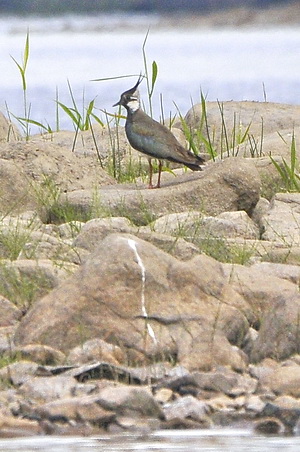
A Study of a Lapwing
(Vanellus vanellus)
The Spit, Lough Allen
Summer 2010
|
|
Breeding Habitats:
The Lapwing typically likes to nest in open grassland where the grass is reasonably short and grazed and where there are no high trees to either block their view or to allow predators (Crows) to perch. This bird is seen flying over a small pasture on the east shore of Lough Allen adjacent to The Spit.
 This is not particularly suitable habitat for this species. This is a Red listed species and is very vulnerable. It has shown big declines in breeding numbers not only in Ireland but also around Europe. They have traditionally bred more successfully in Lough Allen but the trend now is to abandon small breeding areas and to congregate in larger more successful colonies. This is not particularly suitable habitat for this species. This is a Red listed species and is very vulnerable. It has shown big declines in breeding numbers not only in Ireland but also around Europe. They have traditionally bred more successfully in Lough Allen but the trend now is to abandon small breeding areas and to congregate in larger more successful colonies.
Significant successful work has been done by the RSPB in Upper Lough Erne (an environment quite similar to Lough Allen’s) whereby Lapwings have been encouraged to come back by the modification and management of habitat and predator control. Simple measures seem to have produced good results. This is a species and a project that is well suited to a coordinated conservation initiative in Lough Allen between the community, local farmers, and those who would wish to see this attractive species recover and survive here.
|
|
|
|
|
|
|
|
|
Predation:
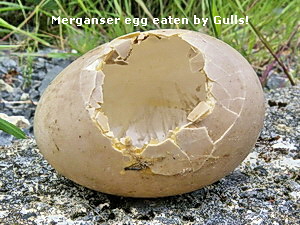 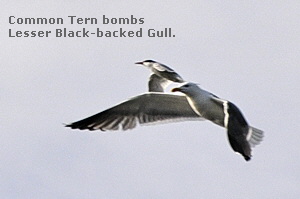 Anyone involved with conservation and biodiversity issues around Lough Allen, will be very much worried about the fluctuating water levels of the Lake, particularly in recent years. However, this Spring and early Summer has been a dry and sunny one with the lake level rapidly descending. Our early concerns about such species as the Merganser, Sandpiper, and the ground nesting species discussed here, being thwarted in breeding by Summer floods, have not materialised. Anyone involved with conservation and biodiversity issues around Lough Allen, will be very much worried about the fluctuating water levels of the Lake, particularly in recent years. However, this Spring and early Summer has been a dry and sunny one with the lake level rapidly descending. Our early concerns about such species as the Merganser, Sandpiper, and the ground nesting species discussed here, being thwarted in breeding by Summer floods, have not materialised.
Instead the normal problems of predation and competition have been evident in the two main breeding areas for marine birds around the lake. On the right is a Merganser egg found on Gull Island. The shape of the hole and the scratches inside the shell suggest that this egg was eaten, not hatched. Presumably by a Lesser Black-backed Gull. The other two pictures show smaller and very agitated nesting birds trying to drive off a predatory Lesser Black-backed Gull flying over ‘their’ island. On the left a Common Tern (apologies for below par photograph) is dive bombing the Gull, and causing it much concern! Below,a pair of Black-headed Gulls are screaming and shouting at a Black-backed Gull. Both these species are quite capable of actually hitting the gull in their attempts to drive it away. The missing wing feathers on the Gull may be a sign of these attacks.
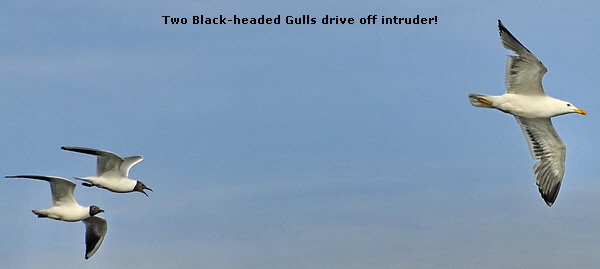 The nesting birds do need to be vigilant as, if Black-backed Gulls are able to land near to their nests, they will very rapidly devour both eggs and chicks and that may be the end of that pairs attempt to breed this year. The Gulls will not attack the adult Terns or Black-headed Gulls and the harrying technique seems to be quite effective in driving the Black-backed Gulls away. However, they do take a big toll of eggs and we have seen many examples of eggs taken and eaten by Black-backed Gulls. This would also include Merganser eggs from Gull Island! The nesting birds do need to be vigilant as, if Black-backed Gulls are able to land near to their nests, they will very rapidly devour both eggs and chicks and that may be the end of that pairs attempt to breed this year. The Gulls will not attack the adult Terns or Black-headed Gulls and the harrying technique seems to be quite effective in driving the Black-backed Gulls away. However, they do take a big toll of eggs and we have seen many examples of eggs taken and eaten by Black-backed Gulls. This would also include Merganser eggs from Gull Island!
It is important that Black-headed Gulls should be encouraged. They will defend their nests and could well be successful if given a chance. This year their breeding pattern on The Spit was noticeably different from the other main resident, the Common Gull. They arrived much later, about the same time as the Terns and they occupied the less vegetated end of The Spit, with the Terns down at the southern tip in among the bare rocks. At the time of writing the Black-headed Gulls are sitting on eggs, though many predated eggs are also present, whilst the Common Gulls have been successful in having many chicks flying and feeding in the shallow water between The Spit and the shore.
|
|
|
|
|
Colonisation:
Black-headed Gulls are quite an aggressive and successful breeder in their own right, even though they are designated as a high-risk Red Listed species. This individual (Below) was photographed at the end of the breeding season on a neighbouring island (Jenny’s Island), where these birds have not been known to breed.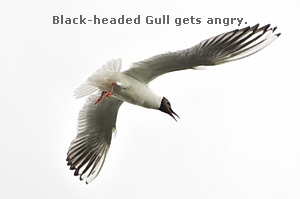
The bird is exhibiting agressive territorial behaviour by screaming and diving at the photographer. Yet there were no eggs or chicks around. This might imply that this bird was prospecting this area as a possible nesting site for next year. Jenny’s Island is actually quite long (though it doesn’t appear on the OSI map) and we often wondered why it was not used by Gulls for nesting. It is heavily wooded and if water levels were high there would not be much exposed shoreline. Perhaps the present low water levels are encouraging this species and the Common Tern (also scouting the area) to expand away from The Spit which is only a short distance away.
This island is popular with Sandpipers and Mallard but otherwise seems under-colonised. However, we think it may be a relatively ‘new’ island because it has a very shoal type substrate and because it is not mapped. Perhaps this is why it does not have established Gull colonies?
|
|
 Black-headed Gulls. Black-headed Gulls.
We have avoided landing on The Spit until birds were seen to be fledged. After young Common Gulls were seen feeding away from the island we found this Black-headed Gulls nest. Other predated eggs were also noticed. It seems that the Black-headed Gulls may have laid much later than the Common Gulls. Also they may be new arrivals to this location, whereas the Common Gulls have been nesting here successfully for many years.
In a reserve north of London, Rye Meads on the Lee River, Black-headed Gulls have recently colonised rafts in a resevoir where they were not traditionally known. The rafts were placed for Common Terns and now the two species are competing with one another, the Black-headed Gulls seeming to win. It would be nice if we could, in some way, manage the natural resources available at Lough Allen so as to enable both of these endangered species to breed successfully!
|
|
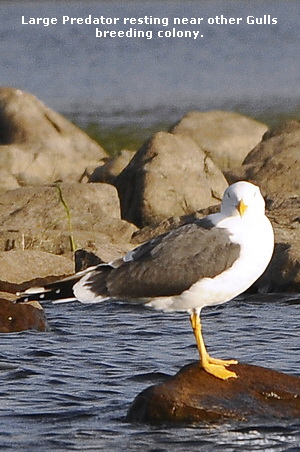 Lesser Black-backed Gull. Lesser Black-backed Gull.
A large gull in comparison to the other two, but not the largest gull in Ireland. The Great Black-backed Gull with a real black back and pink legs is larger but it is a ‘sea’ gull and not much found inland.
But this bird is long enough and has a vicious hooked beak unlike the pointed beaks of the two smaller gulls. It is very predatory and a scavenger, and eggs, chicks, and other dead birds, would be very much part of its diet during the breeding season. However, it is in decline and it is a valued element of our biodiversity.
So how can we combine breeding populations of this species with breeding populations of other also endangered species within a very close range of one another and on a limited number of suitable islands?
|
|
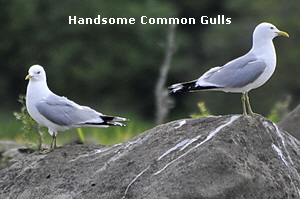 Common Gull. Common Gull.
Actually, not always a common Gull. It is the archetypical English Gull following the plough! Well, we don’t have much ploughing up in Leitrim (though it would add valuable biodiversity to the area), but we do have significant numbers of breeding Common Gulls.
They typically breed in inland waters like Lough Allen but also small mountain lakes elsewhere in the county. Some gulls can rightly be called Sea Gulls but this one and the Lesser Black-backed Gull can be often seen fishing along rivers.
It is a most attractive bird, both in appearance and behaviour, quite dainty and with a ‘mewing’ call. It often looks spectacularly well dressed as in this photogrpah at breeding time. It forms close knit family parties and doesn’t seem to exhibit the aggression shown by the Terns and other gulls. It is however in decline and any conservation measures that can be taken, should be taken. That said, it does well in Leitrim and in one of its main breeding colonies on Lough Allen, The Spit, there seems to be about 10 youngsters on the wing now, or nearly on the wing! These birds like all gulls leave the nest on hatching and walk or swim until they can fly.
Even during the breeding season, Common Gulls are widely dispersed inland. They love to visit meadows where silage has been cut and the grass is short and good for rooting around in to find various invertebrate food that they love. Wherever ground has been mown or ploughed these birds can be found if they are in the area. Are these non-breeding birds or do they fly from the lake down towards Leitrim village specifically in search of feeding? The young birds, initially, seem quite happy feeding in the water along the edge of the breeding colony.
Common Gulls also ‘fish’ along the lake. They can be regularly seen away from the colonies patrolling up and down over the water but not too far from the shore. They often fish a particular patch, flying along the coast for a couple of hundred metres and then back up again. Fishing is by dancing on the water and just picking something off the surface. We are not sure what they are feeding on. But, if you see a tidy gull with yellow beak and legs and a white back, along the lake shore or in your fields... it is a Common Gull and it is not so common in many places as it is around Lough Allen!
|
An Interim Bird Conservation strategy?
The worst ‘victims’ of the Lesser Black-backs may well be Mergansers, Black headed Gulls, and the Terns. The disturbance these predators cause when they approach a colony is enormous, much more than the disturbance caused by a boat or when cattle walk on to the colony. Such disturbance may be tolerated by established breeders such as the Common Gulls. They seem to have learnt to live with one another? But for a few newly colonising ‘new’ species, such as the Terns, these gulls may represent impossible odds.
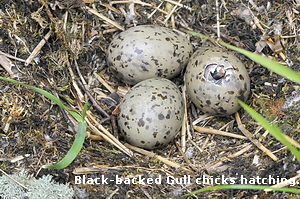 Fortunately, at the breeding area at the south of Lough Allen, they breed on different islands or banks. The Black-backed Gulls are restricted to Round Island. But they do travel continuously to search for food over the colonies of other species nearby. Mergansers unfortunately nest on that island also and seem to have an almost impossible job trying to breed successfully... though they may still do so? Fortunately, at the breeding area at the south of Lough Allen, they breed on different islands or banks. The Black-backed Gulls are restricted to Round Island. But they do travel continuously to search for food over the colonies of other species nearby. Mergansers unfortunately nest on that island also and seem to have an almost impossible job trying to breed successfully... though they may still do so?
|
|
|
|
 Suggestions for maintaining Bird Diversity at Lough Allen: Suggestions for maintaining Bird Diversity at Lough Allen:
1. Tern rafts adjacent to The Spit fitted with anti-gull poles!
2. Nest boxes for Mergansers with a roof and restricted entrance at the Black-backed colonies.
3. Developing some man-made Shoals (like The Spit) to give a wider choice of breeding sites.
4. Providing some cleared grassland areas of sufficient size to encourage more lapwings to breed.
|
|
|
|
|
|
|
|
BACK to Section index.
NEXT Field Report
|
|
|
|
|
|
[MORE TRIPS to come!]
If you have any interesting records of animals or plants from the Lough Allen basin, we will be very pleased to reproduce them here.
|